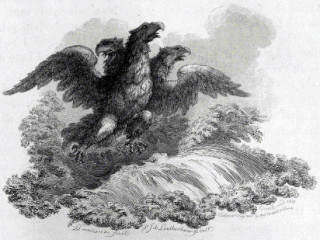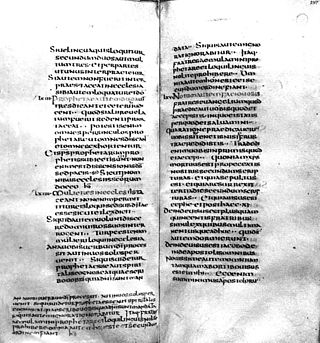Related Research Articles

The Vulgate, sometimes referred to as the Latin Vulgate, is a late-4th-century Latin translation of the Bible.

The Apocalypse of Peter is an early Christian text of the 2nd century and an example of apocalyptic literature with Hellenistic overtones. It is not included in the standard canon of the New Testament, but is mentioned in the Muratorian fragment, the oldest surviving list of New Testament books, which also states that some authorities would not have it read in church. The text is extant in two incomplete versions of a lost Greek original, a later Greek version and an Ethiopic version, which diverge considerably. The work is classed as part of New Testament apocrypha.
The Life of Adam and Eve, also known in its Greek version as the Apocalypse of Moses, is a Jewish apocryphal group of writings. It recounts the lives of Adam and Eve from after their expulsion from the Garden of Eden to their deaths. It provides more detail about the Fall of Man, including Eve's version of the story. Satan explains that he rebelled when God commanded him to bow down to Adam. After Adam dies, he and all his descendants are promised a resurrection.

2 Esdras is an apocalyptic book in some English versions of the Bible. Tradition ascribes it to Ezra, a scribe and priest of the fifth century BC, but scholarship places its composition between 70 and 218 AD.
The name "Esdras" is found in the title of four texts attributed to, or associated with, the prophet Ezra. The naming convention of the four books of Esdras differs between church traditions; and has changed over time.

The Apocalypse of Paul is a fourth-century non-canonical apocalypse and part of the New Testament apocrypha. The full original Greek version of the Apocalypse is lost, although fragmentary versions still exist. Using later versions and translations, the text has been reconstructed, notably from Latin and Syriac translations.

The Ascension of Isaiah is a pseudepigraphical Judeo-Christian text. Scholarly estimates regarding the date of the Ascension of Isaiah range from 70 AD to 175 AD. Many scholars believe it to be a compilation of several texts completed by an unknown Christian scribe who claimed to be the Prophet Isaiah, while an increasing number of scholars in recent years have argued that the work is a unity by a single author that may have utilized multiple sources.
2 Baruch is a Jewish pseudepigraphical text thought to have been written in the late 1st century CE or early 2nd century CE, after the destruction of the Temple in CE 70. It is attributed to the biblical figure Baruch ben Neriah and so is associated with the Old Testament, but not regarded as scripture by Jews or by most Christian groups. It is included in some editions of the Peshitta, and is part of the Bible in the Syriac Orthodox tradition. It has 87 sections (chapters).

The Codex Fuldensis, also known as the Victor Codex, designated by F, is a New Testament manuscript based on the Latin Vulgate made between 541 and 546. The codex is considered the second most important witness to the Vulgate text; and is also the oldest complete manuscript witness to the order of the Diatessaron. It is an important witness in any discussion about the authenticity of 1 Corinthians 14:34–35 and the Comma Johanneum. It is one of the earliest dated manuscripts of the New Testament. It was corrected until 2 May, 546 AD.
Written between the 2nd and 5th centuries AD, in Greek, the Apocalypse of Sedrach, also known as the Word of Sedrach, is an ancient apocryphal text. It is preserved only in one 15th century manuscript. The text was published by M. R. James and translated into English by A. Rutherford. Apparently the original apocalypse was composed between AD 150 and 500, it was joined with a lengthy sermon on love to reach its final form shortly after AD 1000. The original was probably Jewish, but this was later edited to take on a Christian flavour.

The Visio Tnugdali is a 12th-century religious text reporting the otherworldly vision of the Irish knight Tnugdalus. It was "one of the most popular and elaborate texts in the medieval genre of visionary infernal literature" and had been translated from the original Latin forty-three times into fifteen languages by the 15th century, including Icelandic and Belarusian. The work remained most popular in Germany, with ten different translations into German, and four into Dutch. With a recent resurgence of scholarly interest in Purgatory following works by Jacques Le Goff, Stephen Greenblatt and others, the vision has attracted increased academic attention.

Commentary on the Apocalypse is a book written in the eighth century by the Spanish monk and theologian Beatus of Liébana (730–785) and copied and illustrated in manuscript in works called "Beati" during the 10th and 11th centuries AD. It is a commentary on the New Testament Apocalypse of John or Book of Revelation. It also refers to any manuscript copy of this work, especially any of the 27 illuminated copies that have survived. It is often referred to simply as the Beatus. The historical significance of the Commentary is made even more pronounced since it included a world map, which offers a rare insight into the geographical understanding of the post-Roman world. Well-known copies include the Morgan, the Saint-Sever, the Gerona, the Osma and the Madrid Beatus codices.
The Questions of Ezra is an ancient Christian apocryphal text, claimed to have been written by the Biblical Ezra. The earliest surviving manuscript, composed in Armenian, dates from 1208 CE. It is an example of the Christian development of topics coming out from the Jewish Apocalyptic literature. Due to the shortness of the book, it is impossible to determine the original language, the provenance or to reliably date it. This text has had no influence outside the Armenian Apostolic Church.
Minuscule 94 (in the Gregory-Aland numbering), O31 (von Soden), is a Greek minuscule manuscript of the New Testament, on parchment and paper, dated to the 12th or 13th century. Formerly it was labelled by 18a, 21p, and 19r.
Barontius (Barontus) and Desiderius were two 8th century hermits who are venerated as saints by the Catholic Church. They were hermits near Pistoia, in Italy.
The Codex Sangermanensis I, designated by g1 or 7, is a Latin manuscript, dated AD 822 of portions of the Old Testament and the New Testament. The text, written on vellum, is a version of the Latin. The manuscript contains the Vulgate Bible, on 191 leaves of which, in the New Testament, the Gospel of Matthew contain Old Latin readings. It contains Shepherd of Hermas.
The León Palimpsest, designated l or 67, is a 7th-century Latin manuscript pandect of the Christian Bible conserved in the cathedral of León, Spain. The text, written on vellum, is in a fragmentary condition. In some parts it represents the Old Latin version, while following Jerome's Vulgate in others. The codex is a palimpsest.

The Codex Sangallensis 63, designated by S in some critical editions of the Bible, is a 9th-century Latin manuscript of the New Testament. The text, written on vellum, is a version of the Vulgate and contains the text of the Acts of the Apostles, Epistles, Book of Revelation, and non-biblical material. The manuscript has not survived in a complete condition, some parts of it have been lost. The original manuscript did not contain the Comma Johanneum, but it was added by a later hand on the margin.

Ezra 1 is the first chapter of the Book of Ezra in the Old Testament of the Christian Bible, or the book of Ezra–Nehemiah in the Hebrew Bible, which treats the book of Ezra and book of Nehemiah as one book. Jewish tradition states that Ezra is the author of Ezra–Nehemiah as well as the Book of Chronicles, but modern scholars generally believe that a compiler from the 5th century BCE is the final author of these books.

Ezra 4 is the fourth chapter of the Book of Ezra in the Old Testament of the Christian Bible, or the book of Ezra–Nehemiah in the Hebrew Bible, which treats the book of Ezra and book of Nehemiah as one book. Jewish tradition states that Ezra is the author of Ezra–Nehemiah as well as the Book of Chronicles, but modern scholars generally accept that a compiler from the 5th century BCE is the final author of these books. The section comprising chapter 1 to 6 describes the history before the arrival of Ezra in the land of Judah in 468 BCE. This chapter records the opposition of the non-Jews to the re-building of the temple and their correspondence with the kings of Persia which brought a stop to the project until the reign of Darius the Great.
References
- ↑ Gardiner, Eileen (November 11, 1993). Medieval Visions of Heaven and Hell. Routledge. doi:10.4324/9781315055817-19/vision-ezra-visio-beati-esdrae-eileen-gardiner.
- ↑ J. R. Muelller and G. A. Robbins, Vision of Ezra (Fourth to Seventh Century A.D.). A New Translation and Introduction, in James H. Charlesworth (1985), The Old Testament Pseudoepigrapha, Garden City, NY: Doubleday & Company Inc., Volume 2, ISBN 0-385-09630-5 (Vol. 1), ISBN 0-385-18813-7 (Vol. 2). Here cited vol. 1 p. 582.